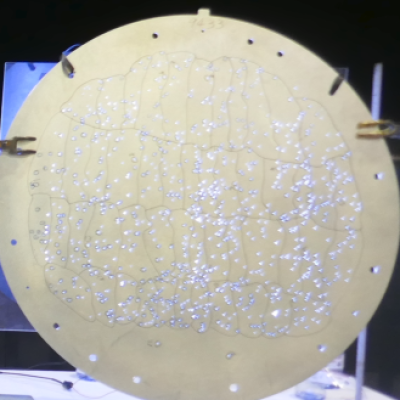Connecting the Star, the Disk, and the Planets
Cool Stars 21 is rescheduled for 4-9 July 2022
Please submit your abstracts and questions below
Cool stars are formed by accretion processes, starting in the Class 0/I phase and lasting well into the Pre-Main Sequence (PMS). Magnetically controlled accretion connects the matter and angular momentum flow in the disk with the central star and affects the disk structure and the formation and migration of planets. Besides being the connection between stellar properties and planets, accretion is a key to understand cool stars.
The last years have seen advances in stellar magnetic fields, accretion rate and disk mass and size estimates, observations of systems with variable accretion, and even the first hints of accretion onto planets, answering some questions but revealing many new ones. How does accretion evolve between the Class 0/Class I and PMS phases? How does the accretion mechanism vary for stars with different masses and ages? And for planets? What is the interplay between accretion and photoevaporation or disk winds? How does accretion proceed in disks with low metallicity, or with low viscosity? Are our measurements of accretion rates biased? In this splinter session, we will address these topics and related issues, bringing together a community of experts in accretion, stars, disks, and planets and aiming to develop future collaborations between accretion-related fields that will continue beyond the meeting.
Some of you submitted an abstract back in 2020. Since it has been a while and we aren’t sure who is still interested in presenting, please do submit them again. Thanks a lot!
For this purpose, we are not only collecting abstracts, but also open questions to lead the discussion. The deadline for the submission of both was May 1st, and we would like to thank all of you who submitted an abstract. We had an overwhelming number of them, and we have now our program schedule (see below).
We aim to have a lively and interactive discussion as well, and to make it more participative, we are collecting your open questions and favourite objects or favourite topics that you would like to discuss in the session. You can submit them using the links below.
Submit a favourite object/favourite topic here (accepting submissions until June 24th!)
For further information, please contact cs21accretion@dundee.ac.uk
Splinter Program – Thursday afternoon
The results of the discussion
The results of the Menti presentation are available as a pdf in the link Splinter Discussion Results
The Menti presentation will be active for 48h (until Saturday 9th, in the morning), so you can still submit something if you wish, using the code in the hybrid session platform.
As we discussed, it may be a good idea to provide some answers, some ideas, and to organize ourselves as a community for e.g. applying for large-scale observing programs or sharing tools, models, data, etc. Therefore, we have created a new presentation that you can also access again at https://www.menti.com/ using the second code I am providing in the hybrid platform. You can also sign up with your name there if you want to stay in touch for possible projects. Because Menti codes are active for 48h only, if there is a lot of interest and the code has expired, let me know and then I will reopen it again.
For the live discussion
Please go to https://www.menti.com/ and use the code we provide in the splinter chat (see hybrid platform).
First part
14:00-14:05 – Intro/welcome (organizers)
14:05-14:35 – Jerome Bouvier: “Accretion introduction and Exploring the magnetospheric accretion region of young stellar systems”
14:35-14:50 – Carys Herbert: “Properties and evolution of surface spots on young stars”
14:50-15:05 – George Pantolmos: “Stable vs. unstable accretion: How to spin down a T Tauri star?”
15:05-15:20 – Eleonora Fiorellino: “Tracing the mass accretion rate in the young population of the NGC1333 cluster”
15:20-15:35 – Caeley Pittman: “Characterization of magnetospheric accretion and extinction in Orion OB1b with the ODYSSEUS Survey”
15:35-15:50 – Camille Stock: “Accretion variability, RU Lup and the Li I photospheric line”
15:50-16:00 – 1 min, 1-slide poster presentations by:
Sarah Betti, Justyn Campbell-White, Adolfo Carvalho, Rik Claes, Ruhee Kahar, Rajeev Manick, Julia Roquette, Aurora Sicilia-Aguilar, Alana Sousa
Second part
16:30-16:45 – Rene Oudmaijer: “The formation and evolution of Herbig Ae/Be stars”
16:45-17:00 – Manuele Gangi: “The GHOsT survey: connecting accretion, disk and wind/jet properties using high-resolution optical and infrared spectroscopy”
17:00-17:15 – Thanawuth Thanathibodee: “The properties of the lowest accretors”
17:15-17:30 – Gabriella Zsidi: “Short-term variability of the highly accreting T Tauri star DR Tau”
17:30-17:45 – Dominika Itrich: “Population of young low-mass stars in a harsh environment of Carina”
17:45-18:00 – Interactive discussion + Favourite objects
Led by Aurora Sicilia-Aguilar and Carlo Manara with contributions of everyone who submits a favourite subject/object (or who wants to say anything).
Open questions
The session will be organised as a led open discussion with very brief presentations/notes from selected speakers from among the participants. The aim of the presentations is not to discuss a particular result or object, but rather to focus on the open problems and how these can be tackled from various points of view, including observations and theory.
In order to focus the discussion, we are collecting open questions from among the participants. Please let us know your own key questions to add them to our list below:
- Accretion through the age of the star and through the age of the galaxy: How does accretion vary in time and what effect does it have on the star and forming planets? What happens for disks with different viscosities or metallicities, including low-metallicity stars?
- Observational techniques: measuring accretion rates and disks masses, with their limitations and open problems, including measuring accretion in very embedded Class 0/I phases.
- The disk mass vs accretion time problem: Are new observations and models (of disks, of accretion variability over time) adding anything new to it? How relevant is disk dissipation through accretion during the optically visible PMS phase compared to other processes such as photoevaporation, winds, planet formation? Is the relative importance of these different processes dependent on the stellar mass, stellar structure (which influences the stellar magnetic field topology and likely the magnetospheric accretion process), or age of the system?
- Accretion vs planet migration: How does accretion affect the formation and migration of planets? How does accretion onto the star compare to accretion through the disk? How does accretion variability modify the planet formation regions?
Organisers
- Aurora Sicilia-Aguilar, Justyn Campbell-White, Soko Matsumura, Scott Gregory (University of Dundee)
- Ignacio Mendigutía (Centro de Astrobiología, Spain)
- Min Fang (Caltech, USA)
- Giovanni Rosotti (Leicester University, UK)
- Carlo Felice Manara (ESO, Germany)
- Veronica Roccatagliata (University of Pisa, Italy)
- Ágnes Kóspál, Peter Ábrahám, Fernando Cruz-Saenz de Miera (Konkoly Observatory, Hungary)
- Gaittee Hussain (ESA, The Netherlands)
- Catherine Espaillat (Boston University, USA)






